| 1 | One of Earth’s most endangered snakes |
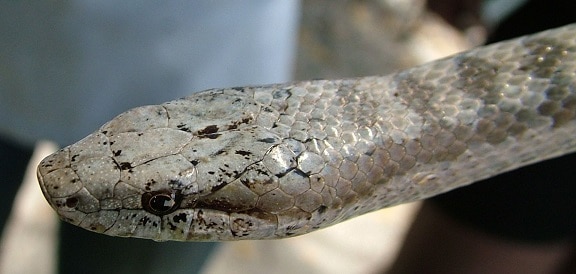
The Antiguan racer is an orange coloured snake about 1 metre long which lives exclusively in hot, humid Antigua. It’s an ambush snake which lacks any venom and is harmless to humans, which feeds mainly on lizards and lurks in dense forest habitats with thick undergrowths. About 20 years ago, however, it had a less welcome claim to fame – it was the world’s rarest snake.
From covering most of Antigua in antiquity, the species had fallen to just 50 individuals remaining when surveyed in 1995. All of these lived on the tiny Great Bird island off the Antiguan mainland, which measures just 9.9 hectares. The species was at its last stand – it occupied just 0.1% of its original range and seemed destined to pass through the doors of extinction forever.
Instead, conservationists came together to deliver one of the greatest snake success stories ever seen. The species is still in the ICUN category of “critically endangered”, but by 2010, the Antiguan racer had recovered to 500 individuals. The most recent population estimate is 1000, and their range has risen 5-fold.
| 2 | Decimated by rats |

Before European colonists arrived in the late 15th century, Antigua was covered with vast untouched forests where lizards roamed in their millions. Antiguan racers had no natural predators, and lived the same idyllic life for generation after generation.
By the 18th century, the forests were being replaced en masse with sugar plantations. The Antiguan racer took its first blow, but the heaviest hit came when the sugar farmers were plagued by an outbreak of black rats, which had hid in the decks of their wooden ships as they sailed across the Atlantic.
By the late 19th century, these rats were at infestation levels, and so the farmers came up with an ingenious idea: releasing Asian mongooses onto Antigua. The goal was to wipe out the rat infestation without lifting a finger, but they failed to take into account that black rats search for food at night while mongooses typically hunt during the day. This meant that the two species never met, but the mongooses did meet the Antiguan racers, and hunted them with a passion when they did. The black rats also ate the snake’s eggs, and assaulted them viciously when they did come into contact.
| 3 | The last sanctuary |
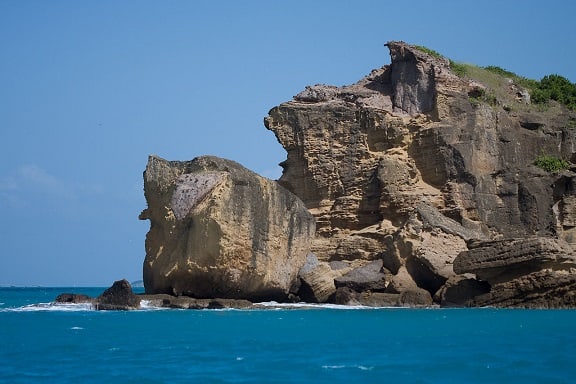
The onslaught of these invasive species was too much, and in 1936, the Antiguan racer was declared extinct. The snake was gone from the mainland and the black rats had spread to every outlying island in the way that only rats can. But there was one secret refuge left, as in the 1960s, biologists collected three living Antiguan racers from Great Bird Island. People deemed it to be the species’ last gasp, but in 1989 there was another sighting on the island.
Great Bird Island lies 2.5km off the north-east coast of Antigua and is barely bigger than a Disneyworld car park. It’s a nature paradise which was named because of the huge number of birds sitting watchfully on its cliffs. Some of these bird species are rare themselves, including West Indian whistling ducks and red-billed tropicbirds.
The island has three sections. To the east, there’s a long coral ridge with 30 metre high cliffs, with a grassy and rocky summit. To the west there’s a round island with thick forest, and connecting the two, there’s a low-lying sandbar with light grasses and plants. In a tiny space, this island had every type of environment the Antiguan racer needed to cling on to survival.
| 4 | Teetering over the brink |
In 1995, a team swooped down on Great Bird Island and conducted an intensive six week survey. They were delighted to find 51 Antiguan racers (not including infants) clinging on to life against all odds, but the task ahead of them was great. The mongeese hadn’t reached the island yet, but black rats were running around everywhere. Many of the Antiguan racers had gnaw marks on their bodies, and 42% had shortened tails. Some of the tails were so short that they wondered whether the males were still able to reproduce.
Simultaneously, the male to female ratio was badly skewed towards females at 1:1.8. At 51 snakes, inbreeding was a strong possibility, and over half of the Antiguan racers had serious injuries overall. 100,000 tourists were visiting the island each year to relax on its white beaches, and without understanding the harmless snakes, some had reacted with fear and clubbed them to death. They’d also left garbage behind, polluting the sacred last refuge. The Antiguan racer was truly at its last gasp.
| 5 | Destroy all rats |
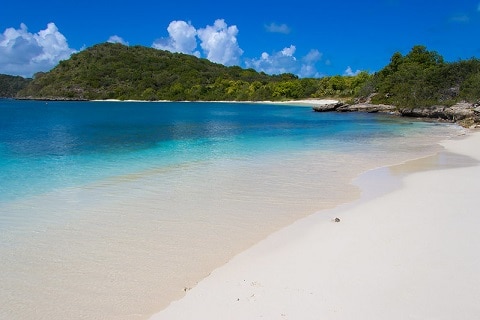
The team quickly got to work, and the first stage was a hardcore plan to eradicate every last black rat on the island. The team wasted no time, and in December 1995, they initiated a military style campaign where they placed 730 blocks of rat poison around Great Bird Island. These were spaced at 10 metres apart using a grid interval system. Most importantly, the wax blocks the poison was mixed with were only palatable to rats – it was a mixture which the native birds and reptiles would never naturally eat. Dr Alan Buckle was brought in from Zeneca Agrochemicals, who recommended the anticoagulant poison brodifacoum for its very short-half life in soil.
No part of the island was exempt. Members of the squad risked their lives by climbing up 30 metre high ledges. Within days, the first dead rats showed up, and within two weeks, every last black rat on the island was dead. To be safe, they kept up the assault for 30 days, and they also cleansed the nearby Galley Islands. To check for reinvasion, the squad placed 30cm long dowlings of wood coated with vegetable oil around the island. Gnaw marks would show that the rats were back, but no gnaw marks appeared.
| 6 | The recovery begins |
By 1998, their efforts had borne fruit. From a low of 51, the Antiguan racer shot up to a population of 114 adults or subadults by early 1997. The lack of rats had allowed their numbers to explode. The only problem was that the new snakes were underweight due to having to share prey, with 17% showing signs of malnourishment like protruding ribs.
The next setback came in the form of Hurricane Georges in September 1998. This vicious storm assaulted Antigua and flooded Great Bird Island up to the sandbar. Snake numbers began to fall again, and reached a fresh low of 81 in the year 2000. Fortunately, the nearby islands made up for it, as in 1999, the anti-rat squad gave the nearby Rabbit Island the cleansing treatment. 10 healthy Antiguan racers were released, and in 2001, they followed up with Green Island, where the first baby snakes were spotted in 2005. It was estimated that Green Island could support 700 well-nourished Antiguan racers, significantly more than the estimated 100 of Great Bird Island.
In 2006, disaster almost struck, as black rats were once again detected on Green Island. Somehow, the persistent little blighters had swam across the ocean or hidden themselves in boats used by tourists. This reinvasion was swiftly halted and the Antiguan racer lived on.
| 7 | The current situation |
Today, there’s an estimated 1000 Antiguan racers in the world. Throughout the 1990s, it had the unfortunate honour of being the world’s rarest snake and international newspapers devoted several articles to it. These days, it’s the closely related Saint Lucia racer which is the rarest snake, with the rarest US snake being the Louisiana pinesnake. The Antiguan racer was officially denoted as “critically endangered” in 1996 (which was quite late) and that status remains to this day.
In 2008, the team added a fourth island to its range: York Island. While this was happening, they sent squads of teachers around Antiguan classrooms to teach people that the snake was gentle, and wasn’t to be feared.
One project which didn’t go so well was breeding Antiguan racers in captivity. Fauna and Flora International took 5 adults into captivity in February 1996, including three males and two females, and successflully bred them to produce 11 eggs. The snakes were kept in Jersey zoo and 6 of the eggs hatched. But it turned out that as a species, Antiguan racers are unusually vulnerable to the common parasite of snake mites (Ophionyssus natricis). Even tiny infections provoked a severe allergic response beyond the level of most snake species. All but one Antiguan racer died, and she had to be kept in extreme isolation.
| 8 | Diet: mainly fellow reptiles |
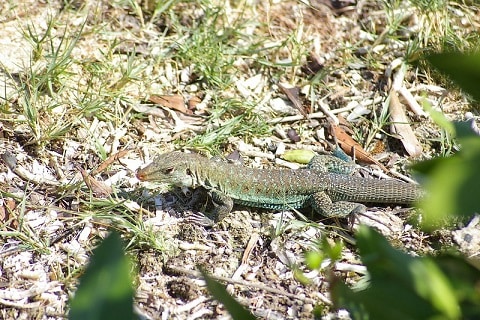
The Antiguan racer has a more particular diet than many snakes. Like the Asian vine snake, its diet mostly consists of lizards, as the team learnt in 1996 when they attempted to feed the captive snakes mice and chicks, only for them to turn their nose up. The snake would only accept live lizards or the tasty sounding recipe of Dinosaur Nutrition’s Snake Steak (TM) sausages. This fussiness was another reason why they survived so poorly.
In the wild, the species’ favourite dishes are well known. They’re particularly reliant on anole lizards, with one being the Watt’s anole (Anolis wattsi). This species is native only to Antigua and is only 6cm long, with a light brown colour. It’s usually spotted on trees, or on buildings and lampposts in inhabited areas.
Another common meal is the Antiguan ground lizard (Pholidoscelis griswoldi), which is a threatened species itself. This is a grey-green lizard with a long tail, which is particularly common on the Antiguan islands. In the dark days of isolation on Great Bird Island, this was the Antiguan racer’s main food source. They occasionally eat the Antiguan least gecko (Sphaerodactylus elegantulus) as well, which is native to Antigua and Barbuda, and is very small and grey.
| 9 | The Antiguan racer lifestyle |
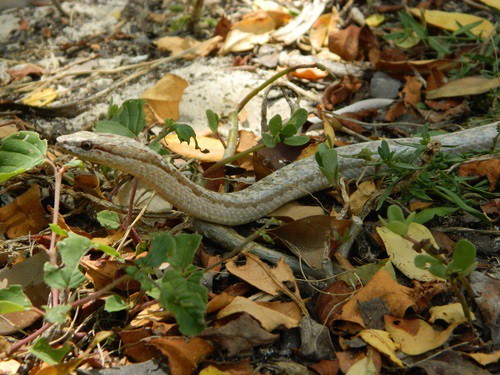
The Antiguan racer might live on isolated tropical islands, but it rarely lies around on the beach enjoying the sunshine. The species mostly dwells underground, beneath rock crevices or in caverns painstakingly carved out by other animals. It’s an ambush predator, and its ambush strategy is quite unique.
For most of the day, the Antiguan racer sits motionless in piles of leaf litter. The only part of its body visible is its head, like a leafy version of the desert horned viper in Africa which buries itself up to the eyeballs. The Antiguan racer waits patiently, until a lizard walks past, at which point it springs out of its lurking place and swallows the prey alive. We know a lot about this snake thanks to the hard-fought conservation battles (which are still raging), and its preferred habitat seems to be thick, dense undergrowth, with plenty of leaves littering the ground and a high percentage of canopy cover.
The Antiguan racer is a day-faring snake (diurnal), and in one study, it awakened at an average time of 6:45, and retreated to the shadows at 17:45.
| 10 | Male-female discrepancies |
Despite being more common than before, the Antiguan racer still has one rare quality to boast about to its snake mates. This is a species where the males and females look unusually different. The females have a silvery-grey base of scales with brown blotches up top. The males are dark-brown, with creamy-coloured blotches. The females are also significantly longer, with a maximum length of 99cm versus 59.5cm in males.
Whether this snake had any subspecies will likely never be known, given how the 1000-strong population of today came from just 51 original snakes. It was never well researched even at its peak in the 19th century, but there were many different subpopulations on the Antiguan islands, separated into distinct genetic pools, so the chances of a few subspecies are very high.
There’s another mystery surrounding this snake as well – whether it ever lived on the neighbouring island of Barbuda, the second main island of the nation. The Antiguan racer was never recorded there in recent history, but relatively recent sub-fossils were unearthed in 1994. It’s possible that European colonists never noticed the snake, or that an ancient natural catastrophe wiped them out and that the snakes had already retreated due to natural causes.
